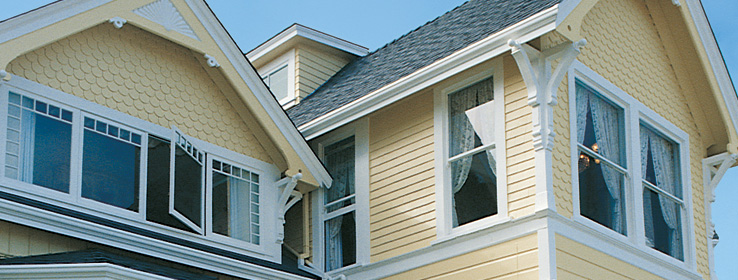Exterior color choices for homes are a balance of what the homeowner likes, or in the case of new construction, what the homebuilder offers, leveraged against prevailing color themes indigenous to the region. For residential exteriors, look at the color palettes used on neighboring homes and in neighboring communities. In most cases, color themes are derived from a region's landscape or topography, its weather and climate patterns, and, of course, its unique cultural history.
So, what's popular in arid, mountainous Santa Fe, with its Native American and Mexican influences, most likely won't be popular elsewhere. But if Santa Fe's palette of turquoise and sand doesn't work for Peoria — or Peekskill, Portland and beyond — then what does? And why?
New England
New England homes reflect the area's traditional values, rich history and landscape of rolling green hills, slate-colored mountains and subdued gray waters. New Englanders prefer a conservative palette for exterior siding, and pick lighter shades from the tan, yellow, gray and white tints. They punch up these tranquil tones with door, window, shutter and trim accents painted in navy blues and vivid berry shades, often in high-gloss finishes.
New Yorkers show the same preference for light siding colors and glossy contrasting trim shades, but often add a red or green entry door finished in a high gloss, and wrap their homes with white picket fences.
Mid Atlantic and Southeastern Coastal
Like New Englanders, homeowners along the Mid-Atlantic to Southeastern Coastal corridor prefer neutrals from the tan, gray and white color families, but they pick shades with more depth. These deeper tones reflect the natural surroundings of sand, sea grasses and the green-gray waters of the Atlantic Ocean.
Despite strong sunshine in southern coastal Georgia and Florida, homes here wear exterior colors of mid-toned neutrals, accented with white or pastel trim. Improved fade-resistant paints and stains make it possible for trim and accents to be painted in various shades of Sunbelt pastels, such as melon or orange.
Midwest
In the nation's heartland, creams, whites and light beiges are the rule for exterior siding, while window trim, shutters and entry doors wear coats of deep burgundy or forest green. Why? Like New England, this is an area where tradition dominates, so color choices swing toward the conservative shades of the spectrum. Light neutrals blend well in virtually any neighborhood, and provide a calm canvas for the green foliage and multicolored landscaping so popular in residential communities. Light neutrals also echo the shades of wheat, corn and other farm crops that are the heart of the heartland.
South
Think Southern states, and images of antebellum-era white-pillared plantation homes come to mind. Some 13 decades after the Civil War, this straightforward palette is resurging in popularity, especially in Deep South states like Louisiana. Though the region cycled through exterior neutrals from the beige family about 15 years ago, paint experts here report most new homes are sided in white or painted white. Homeowners often add cool green tones to shutters, roofs and awnings.
Western Mountain
Homeowners in Mountain states prefer natural colors — like the mid-toned "yellowy" tans of the area's foliage. Love of the outdoors is reflected in the popularity of rustic, natural materials like wood siding, stained in mid tones, and stone. As elevation increases, homeowners tend to forego the deepest tones because of the sun's harsh, fade-accelerating rays.
Southwest
In Texas everything is big, including the region's preference for sophisticated neutrals that blend as well with flat prairies as they do with Gulf Coast waters. The popular gray and tan shades of masonry products for home construction are often complemented with cool neutrals for the painted or sided areas of these homes.
In Arizona desert regions, neutrals step down into darker tones of deep taupe and are trimmed with mid-toned shades in the same color family. Homeowners and builders select neutral greens because these shades blend with the mountain and desert surroundings. But Southwestern homes also echo the area's ethnic influences, so not all neighborhoods wear the grays and tans of the neutral palette. In Santa Fe, of course, sand and turquoise are popular.
And, in El Paso, Texas, just over the border from Mexico, bright blues, golds and terra cottas work side-by-side with neutral tans and creams. These colors reflect not only the unique culture of the area, but also the terrain.
West Coast
Pacific Coast state residents favor shades of gold, yellow, wheat and sage-tinged green for their homes, moving into a color palette that's more evocative of new millennium tones. Homeowners along the coast like cheerful yet sophisticated hues that reflect colors found in the surrounding environment. While still earth tones, these yellow and green shades move away from browns and swing toward sunny, warm colors.
The National Spectrum
With the notable exception of the West Coast region, where varying levels of yellow are popular, home colors seem to begin as light and white shades along the East Coast, move to light neutrals in the Midwest and shift to mid- and deep-toned neutrals in Mountain zones. Yet while neutrals continue to dominate, research indicates homeowners do like color. Increasingly, homeowners are spicing up neutral siding with vibrant, eye-catching colors on doors, shutters, windows and trim.
So, what
doesplay in Peoria? A cool blend of light taupe siding and deep green trim.




